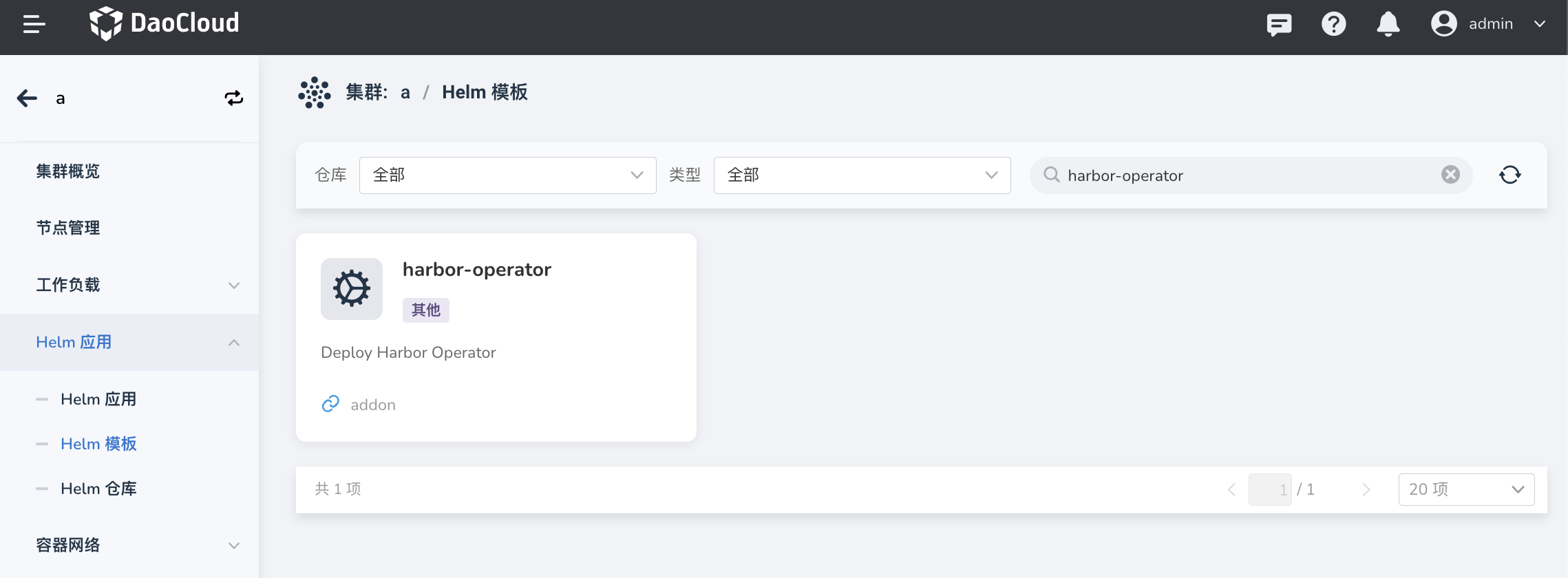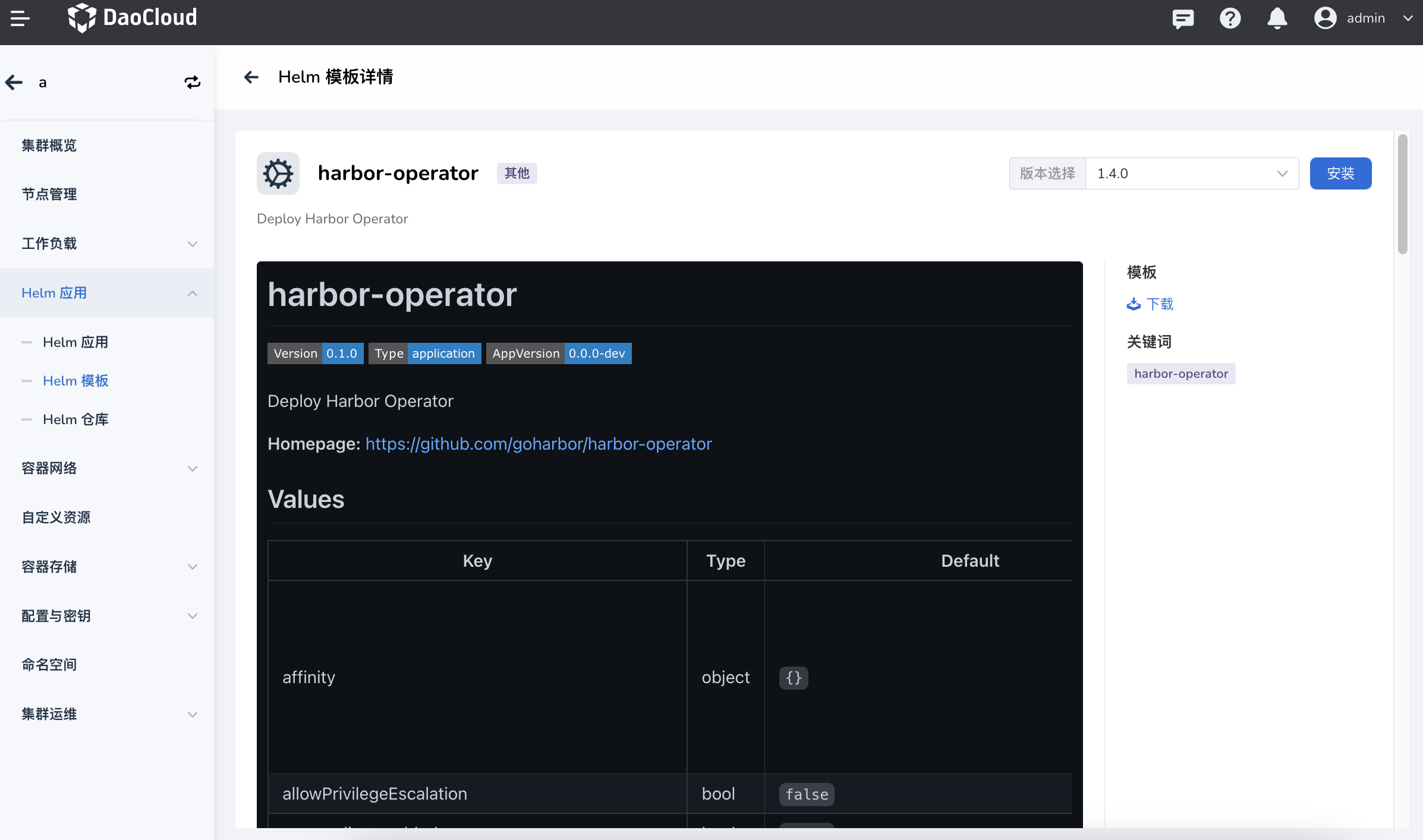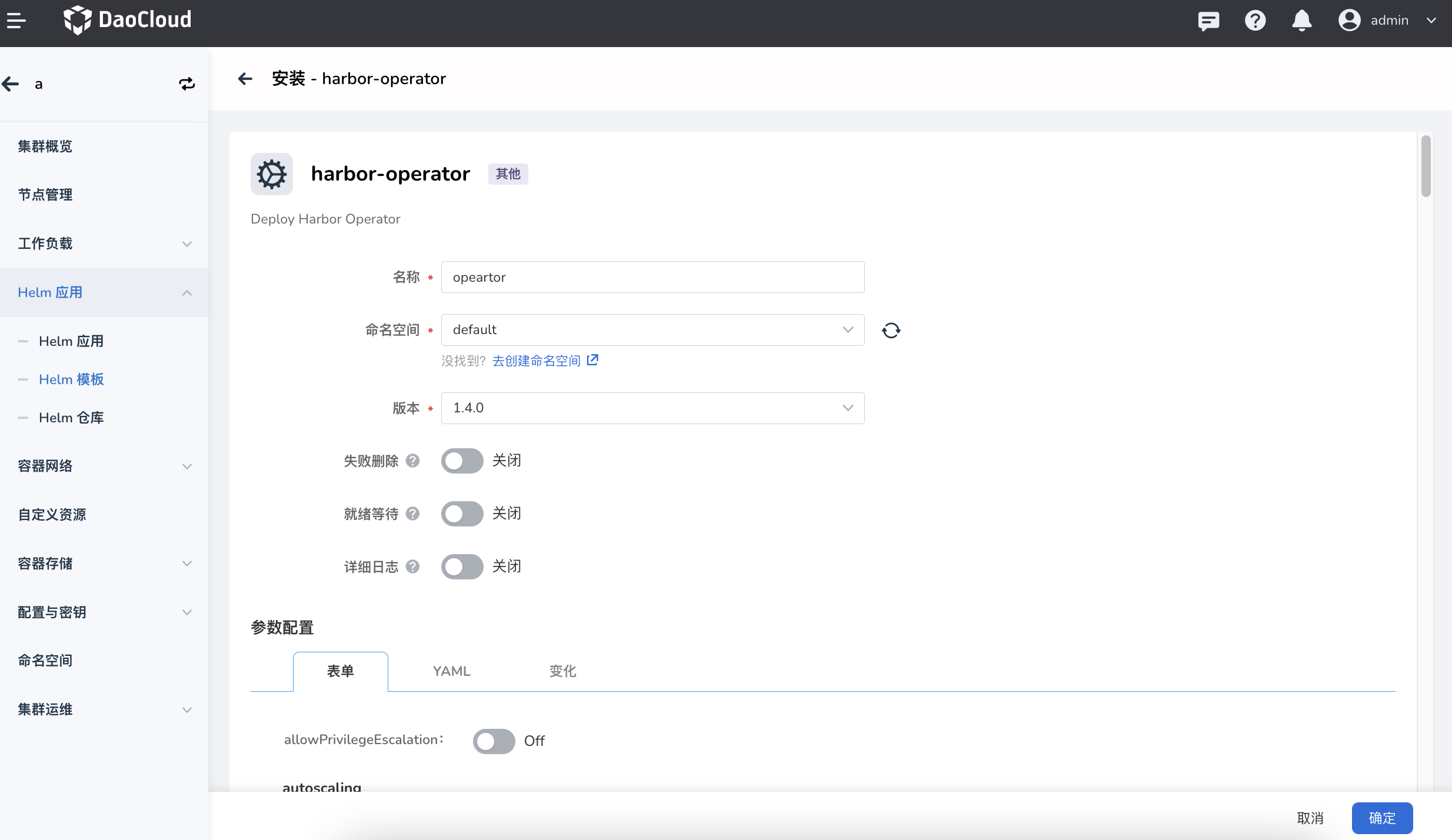安装 Harbor Operator¶
托管 Harbor 使用的是 Harbor Operator 技术来进行 Harbor 创建、升级、删除等全生命周期管理。 在创建托管 Harbor 之前,需要先在容器管理中安装 Harbor Operator,版本要求最低 1.4.0。
Tips: Harbor Operator 依赖Cert Manager,所以需要先安装Cert Manager成功。
-
如果在创建 Harbor 实例时,出现以下异常提示,请点击
前往安装。
-
进入
容器管理的Helm 应用->Helm 模板,找到并点击 Harbor Operator 卡片。
-
选择版本,点击
安装。
-
输入名称和命名空间后,点击
确定,如果想要添加其他参数请参考下面的Values表格。。
-
等待安装完成。

Values¶
Harbor Operator 在安装过程中有较多参数可以填写和控制,具体参数请参考如下表格内容,:
其中
minio-operator.enabled和postgres-operator.enabled和redis-operator.enabled只能为false。
| Key | Type | Default | Description |
|---|---|---|---|
| affinity | object | {} | Expects input structure as per specification https://kubernetes.io/docs/reference/generated/kubernetes-api/v1.18/#affinity-v1-core For example: { "nodeAffinity": { "requiredDuringSchedulingIgnoredDuringExecution": { "nodeSelectorTerms": [ { "matchExpressions": [ { "key": "foo.bar.com/role", "operator": "In", "values": [ "master" ] } ] } ] } } } |
| allowPrivilegeEscalation | bool | false | Allow privilege escalation for the controller Pods |
| autoscaling.enabled | bool | false | Whether to enabled Horizontal Pod Autoscaling |
| autoscaling.maxReplicas | int | 100 | Maximum conroller replicas |
| autoscaling.minReplicas | int | 1 | Minimum conroller replicas |
| autoscaling.targetCPUUtilizationPercentage | int | 80 | CPU usage target for autoscaling |
| autoscaling.targetMemoryUtilizationPercentage | int | No target | Memory usage target for autoscaling |
| controllers.chartmuseum.maxReconcile | int | 1 | Max parallel reconciliation for ChartMuseum controller |
| controllers.common.classname | string | "" | Harbor class handled by the operator. An empty class means watch all resources |
| controllers.common.networkPolicies | bool | false | Whether the operator should manage network policies |
| controllers.common.watchChildren | bool | true | Whether the operator should watch children |
| controllers.core.maxReconcile | int | 1 | Max parallel reconciliation for Core controller |
| controllers.harbor.maxReconcile | int | 1 | Max parallel reconciliation for Harbor controller |
| controllers.harborConfiguration.maxReconcile | int | 1 | Max parallel reconciliation for HarborConfiguration controller |
| controllers.harborcluster.maxReconcile | int | 1 | Max parallel reconciliation for HarborCluster controller |
| controllers.jobservice.maxReconcile | int | 1 | Max parallel reconciliation for JobService controller |
| controllers.notaryserver.maxReconcile | int | 1 | Max parallel reconciliation for NotaryServer controller |
| controllers.notarysigner.maxReconcile | int | 1 | Max parallel reconciliation for NotarySigner controller |
| controllers.portal.maxReconcile | int | 1 | Max parallel reconciliation for Portal controller |
| controllers.registry.maxReconcile | int | 1 | Max parallel reconciliation for Registry controller |
| controllers.registryctl.maxReconcile | int | 1 | Max parallel reconciliation for RegistryCtl controller |
| controllers.trivy.maxReconcile | int | 1 | Max parallel reconciliation for Trivy controller |
| deploymentAnnotations | object | {} | Additional annotations to add to the controller Deployment |
| fullnameOverride | string | "" | |
| harborClass | string | "" | Class name of the Harbor operator |
| image.pullPolicy | string | "IfNotPresent" | The image pull policy for the controller. |
| image.registry | string | "docker.io" | The image registry whose default is docker.io. |
| image.repository | string | "goharbor/harbor-operator" | The image repository whose default is the chart appVersion. |
| image.tag | string | "dev_master" | The image tag whose default is the chart appVersion. |
| imagePullSecrets | list | [] | Reference to one or more secrets to be used when pulling images https://kubernetes.io/docs/tasks/configure-pod-container/pull-image-private-registry/ For example: [ {"name":"image-pull-secret"} ] |
| installCRDs | bool | false | If true, CRD resources will be installed as part of the Helm chart. If enabled, when uninstalling CRD resources will be deleted causing all installed custom resources to be DELETED |
| leaderElection.namespace | string | "kube-system" | The namespace used to store the ConfigMap for leader election |
| logLevel | int | 4 | Set the verbosity of controller. Range of 0 - 6 with 6 being the most verbose. Info level is 4. |
| minio-operator.enabled | bool | false | Whether to enabled MinIO Operator |
| nameOverride | string | "" | |
| nodeSelector | object | {} | Expects input structure as per specification https://kubernetes.io/docs/reference/generated/kubernetes-api/v1.18/#nodeselector-v1-core For example: [ { "matchExpressions": [ { "key": "kubernetes.io/e2e-az-name", "operator": "In", "values": [ "e2e-az1", "e2e-az2" ] } ] } ] |
| podAnnotations | object | {} | Additional annotations to add to the controller Pods |
| podLabels | object | {} | Additional labels to add to the controller Pods |
| podSecurityContext | object | {"runAsNonRoot":true,"runAsUser":65532} | Expects input structure as per specification https://kubernetes.io/docs/reference/generated/kubernetes-api/v1.18/#podsecuritycontext-v1-core For example: { "fsGroup": 2000, "runAsUser": 1000, "runAsNonRoot": true } |
| postgres-operator.configKubernetes.secret_name_template | string | "{username}.{cluster}.credentials" | |
| postgres-operator.enabled | bool | false | Whether to enabled Postgres operator |
| priorityClassName | string | "" | priority class to be used for the harbor-operator pods |
| rbac.create | bool | true | Whether to install Role Based Access Control |
| redis-operator.enabled | bool | false | Whether to enabled Redis Operator |
| redis-operator.image.tag | string | "v1.2.0" | |
| replicaCount | int | 1 | Number of replicas for the controller |
| resources | object | {"limits":{"cpu":"500m","memory":"300Mi"},"requests":{"cpu":"300m","memory":"200Mi"}} | Expects input structure as per specification https://kubernetes.io/docs/reference/generated/kubernetes-api/v1.18/#resourcerequirements-v1-core |
| service.port | int | 443 | Expose port for WebHook controller |
| service.type | string | "ClusterIP" | Service type to use |
| serviceAccount.annotations | object | {} | Annotations to add to the service account |
| serviceAccount.create | bool | true | Specifies whether a service account should be created |
| serviceAccount.name | string | "" | The name of the service account to use. If not set and create is true, a name is generated using the fullname template |
| strategy | object | {} | Expects input structure as per specification https://kubernetes.io/docs/reference/generated/kubernetes-api/v1.18/#deploymentstrategy-v1-apps For example: { "type": "RollingUpdate", "rollingUpdate": { "maxSurge": 0, "maxUnavailable": 1 } } |
| tolerations | list | [] | Expects input structure as per specification https://kubernetes.io/docs/reference/generated/kubernetes-api/v1.18/#toleration-v1-core For example: [ { "key": "foo.bar.com/role", "operator": "Equal", "value": "master", "effect": "NoSchedule" } ] |
| volumeMounts | list | [] | Expects input structure as per specification https://kubernetes.io/docs/reference/generated/kubernetes-api/v1.18/#volumemount-v1-core For example: [ { "mountPath": "/test-ebs", "name": "test-volume" } ] |
| volumes | list | [] | Expects input structure as per specification https://kubernetes.io/docs/reference/generated/kubernetes-api/v1.18/#volume-v1-core For example: [ { "name": "test-volume", "awsElasticBlockStore": { "volumeID": "<volume-id>", "fsType": "ext4" } } ] |
下一步:创建托管 Harbor 实例